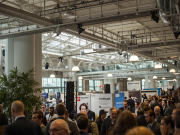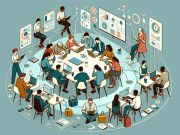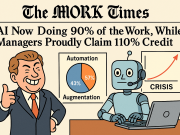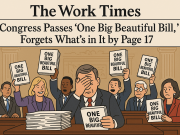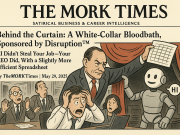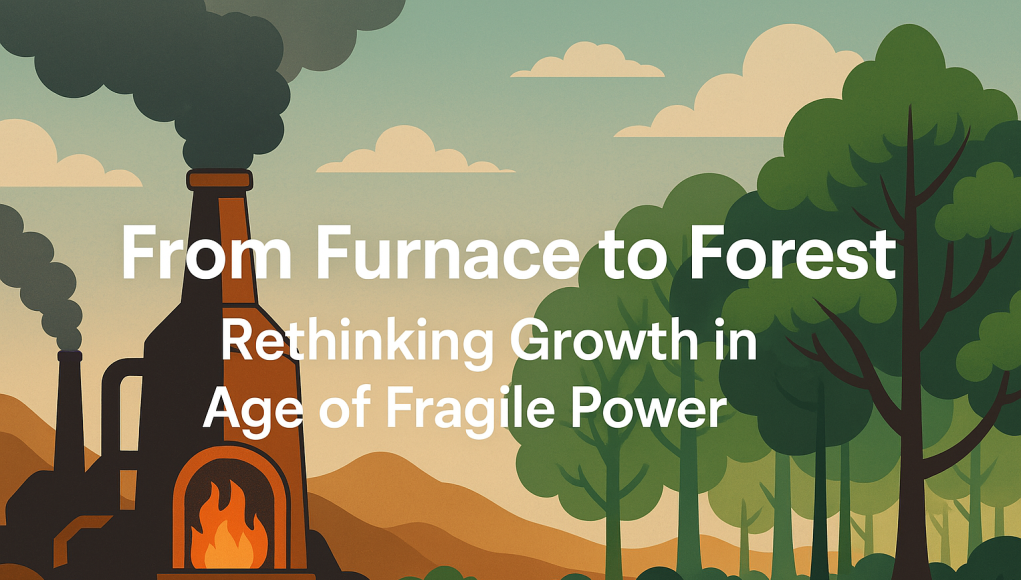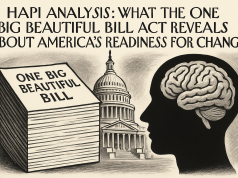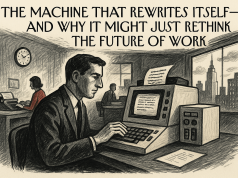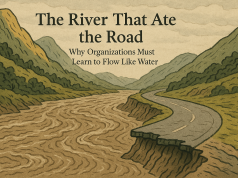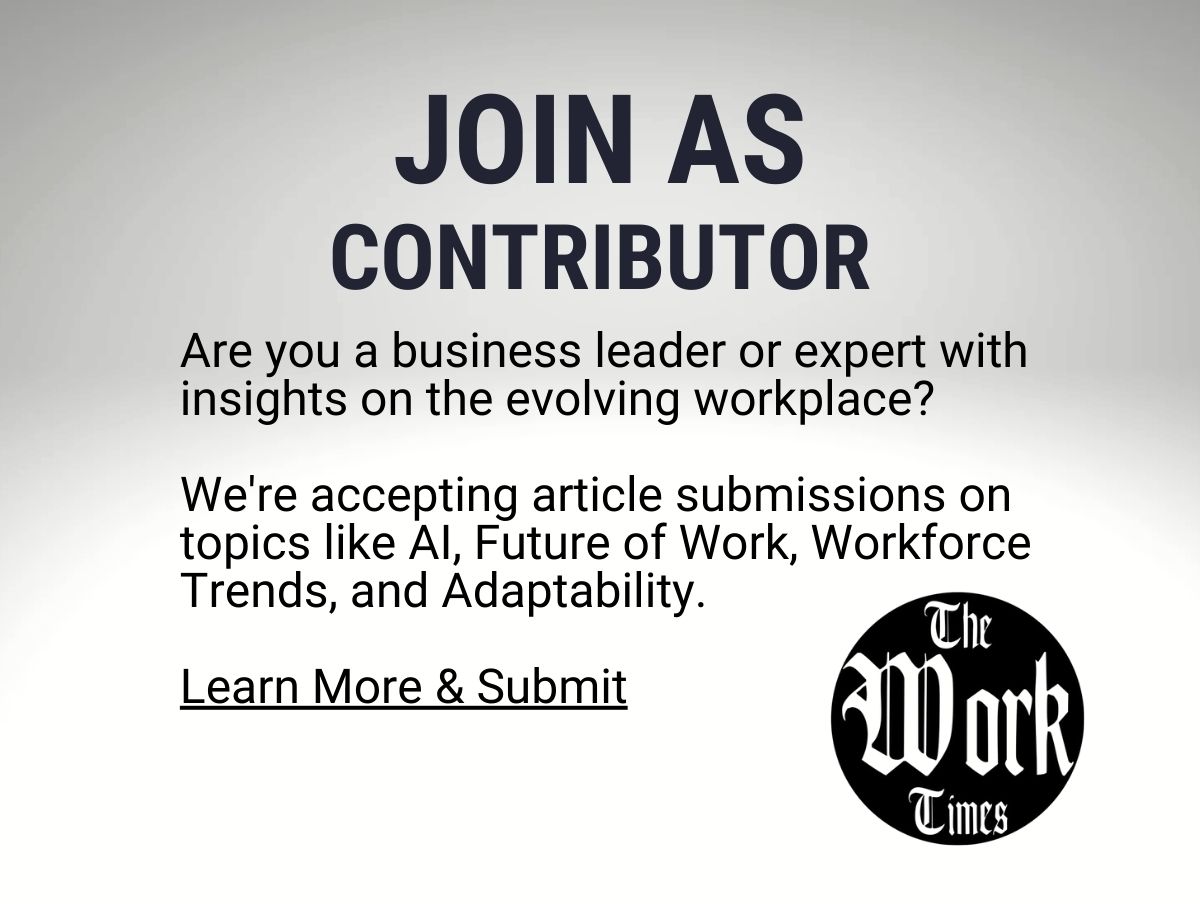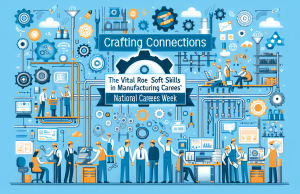In the Himalayan foothills, the snow fox survives not by force but by finesse. It senses the faintest vibrations beneath thick snow, pinpoints its prey, and strikes with uncanny precision. Meanwhile, the tiger—larger, louder, and lauded—struggles when the cold arrives. Nature, in her subtle cruelty, often favors the adaptive over the admired.
America, for a long time, was the tiger. Fearless. First. Loud. But somewhere between the crackle of assembly lines and the birth of the internet, we stopped listening for the snow fox underfoot.
This past week, headlines trumpeted a new round of sweeping tariffs—economic self-sabotage draped in stars and stripes. The intent? Reclaim manufacturing glory. The outcome? More likely a punch to our own gut, with a patriotic bow.
We’ve seen this story before. In Greek mythology, King Midas begged the gods to make everything he touched turn to gold. His wish was granted. But he soon realized that gold doesn’t feed, love, or evolve. We too seem enchanted by the illusion of golden-era factories—when what we really need is fertile ground for new growth.
Lesson One: You Can’t Grow Orchids in a Blast Furnace
In the highlands of Colombia, there’s a flower so delicate it only blooms when the temperature, humidity, and light align just right. The orchid. Beautiful, intricate, and notoriously hard to grow. Now, imagine someone trying to nurture this orchid inside a steel blast furnace—1,500 degrees Fahrenheit of good intentions gone wrong.
That’s what our current economic strategy feels like.
As leaders and policymakers race to “revive American manufacturing,” there’s a temptation to crank up the heat—tariffs, regulations, nationalist fervor—believing pressure alone will spark productivity. But we’re mistaking brute force for brilliance. Orchids don’t bloom under threat. And neither does modern innovation.
Nostalgia Is Not a Strategy
When I hear phrases like “bringing jobs back” or “reclaiming our manufacturing glory,” I imagine someone trying to rewind a cassette tape with a pencil in a Spotify world. Sure, it feels satisfying. It even looks productive. But the music has moved on.
Yes, there was a time when the hum of assembly lines was the heartbeat of progress. It put food on tables, pride in work, and a car in every garage. But those jobs were born in a pre-digital era—when scale meant size, and productivity meant muscle. Today, scale is distributed. Intelligence is modular. And value is created not in factories, but in the invisible architecture of ecosystems—data, code, collaboration, compassion.
We’re not short on energy. We’re short on alignment.
That’s why tariffs—our policy equivalent of a blast furnace—might stir action, but not growth. Heat can melt steel, yes. But it also wilts the very roots of innovation: trust, foresight, and human potential.
The Danger of Growing the Wrong Things, the Wrong Way
Let me share a story from nature.
In parts of Australia, certain seeds only germinate after a bushfire. The heat cracks the outer shell and allows life to emerge. But here’s the thing—those fires are part of a natural cycle. Controlled. Seasonal. Predictable. When fires are too frequent or too intense, the entire ecosystem collapses. The very life they’re supposed to trigger is lost to ash.
The same applies to our economy.
Disruption, when guided wisely, can spur renewal. But uncalibrated force—like across-the-board tariffs, decoupling without strategy, or knee-jerk reshoring—only scorches the soil.
We risk building an economic greenhouse where only the hardiest weeds survive—low-margin, high-drudgery jobs that offer little dignity and even less resilience. Meanwhile, the high-value “orchids”—like AI development, biotech manufacturing, and ethical automation—struggle to take root in an ecosystem starved of nuance, investment, and long-term vision.
From Furnace to Forest: What Real Growth Requires
The future belongs not to those who yell the loudest, but to those who build the quietest systems—the ones that make it easy for talent to thrive, tools to evolve, and trust to multiply.
That’s why at TAO.ai, we’ve focused not just on technology, but on ecosystem architecture. It’s not about bringing back the jobs of the 1950s; it’s about rethinking what meaningful work looks like in 2050.
Do we need manufacturing? Absolutely. But not the kind that locks humans into repetitive roles. We need advanced manufacturing that partners with humans—AI-powered, ergonomically sound, and emotionally sustainable. We need learning systems that evolve with the worker, not ones that discard them the moment a cheaper alternative emerges. We need leadership that values community capacity over corporate consolidation.
And most of all, we need policies that understand what it takes to grow orchids.
The Orchid Blueprint
So what does that look like?
- Precision, Not Pressure – Instead of blanket tariffs, use data-driven micro-policies that encourage high-value production and ethical reshoring in specific sectors (e.g., semiconductors, medical robotics). Heat with purpose, not rage.
- Soil Health First – Invest in the fundamentals: education, mental wellness, digital access. No orchid thrives in barren soil. Worker1—the compassionate, creative professional—is our best climate-resistant species.
- Pollinate the Network – Like orchids relying on symbiotic fungi and hummingbirds, innovation thrives in connected systems. Strengthen partnerships between academia, startups, public labs, and community incubators. Build trust-rich environments.
- Light and Shade – Not all innovation happens under fluorescent lights. Create flexible workspaces—like Ashr.am—that balance productivity with peace. A mind that can breathe is a mind that can build.
Lesson Two: The Fire That Forged Iron Also Burned Empires
In the heart of ancient Mesopotamia, blacksmiths were revered not just as craftsmen, but as gatekeepers of civilization. They forged tools that tilled soil, swords that won battles, and plows that fed empires. Fire, in their hands, was sacred—a transformative force.
But history whispers a quieter truth: the same fire that shapes can also scorch.
Empires rise on the back of innovation. They fall when that same fire turns inward—unchecked, unexamined, and unleashed without wisdom.
America, today, stands at a similar crossroads. We are once again playing with fire—this time in the form of sweeping economic policy, reactionary tariffs, and an obsession with “control” over supply chains. But if history teaches us anything, it’s this: the tools of growth can become the instruments of collapse if we forget why we forged them in the first place.
Empire by Scale, Collapse by Assumption
Consider the Roman Empire.
Its roads connected continents. Its aqueducts brought water to the desert. Its legions, its bureaucracy, its engineering—each an ode to organized scale. But eventually, the very complexity that once fueled Rome’s ascent became its burden. The systems that required constant upkeep began to decay under the weight of arrogance and overreach. Rome didn’t fall in a day. It burned slowly—bureaucracy choking innovation, power distancing itself from purpose.
Sound familiar?
Today, we speak of reclaiming economic power, reshoring manufacturing, outcompeting foreign giants. But are we doing this to strengthen the worker? Or are we simply reenacting rituals of strength to soothe our own nostalgia?
Because forging policy without empathy, without clarity, is still forging. But it doesn’t build—it burns.
From Arsenal to Ecosystem
There’s a fable in Indian folklore of a blacksmith who became so powerful that kings came to him for weapons. Over time, he grew proud. He believed his fire could solve any conflict. When a local village asked for tools to harvest their crop, he gave them spears instead. “Protect your land,” he said.
The land, sadly, went untilled. The village starved.
This is the danger of singular thinking—where every challenge is seen through the same narrow lens of dominance. We’ve begun to treat our economy like a battlefield, not a garden. But strength isn’t just in defense—it’s in resilience.
Modern economic strength must be ecological. Not an arms race, but an arms embrace—a recognition that innovation today is decentralized, layered, and deeply human.
We need blacksmiths, yes. But ones who can forge trust just as well as they forge tools.
When Fire Is Weaponized, Everyone Gets Burned
Tariffs, in theory, are strategic tools. But deployed indiscriminately, they mimic the very colonial impulses that fractured global trust a century ago. They signal fear masquerading as force. And worse, they ignore the interwoven complexity of modern supply chains—where cutting off one partner may unravel ten others.
We’ve seen it before.
The British Empire taxed its colonies into resistance. The Soviet Union centralized its industry into stagnation. Both tried to enforce control where they should have built consensus. Their fires burned bright, but without stewardship, they consumed their own foundations.
Today, when we slap tariffs on raw materials used for building factories, or punish companies investing in automation and innovation abroad, we’re not “protecting” American workers—we’re dousing them in the very fire we claim to control.
We risk becoming the empire that forgets its forge was once a place of creation, not coercion.
From Fire to Forge: A Blueprint for Smarter Strength
So what does principled power look like?
- Toolmaking, Not Torch-Wielding – Craft policies that empower industries to adapt, not retreat. Support modular manufacturing, ethical automation, and workforce reskilling—not reactive protectionism.
- Honor the Local, Trust the Global – Strengthen domestic capabilities without breaking international bonds. America doesn’t have to do everything alone. It just has to do what it does best—with allies, not adversaries.
- Temper Heat with Humility – Fire without purpose destroys. But controlled, it tempers steel. The same should be true of leadership. Create economic heat through targeted investment, clear vision, and long-term thinking—not populist applause.
- Build Ecosystems, Not Arsenals – True strength comes from thriving ecosystems: interdependent, values-driven, and adaptable. At TAO.ai, our work is about building those ecosystems—where Worker1 thrives not in silos of fear, but networks of collaboration.
Lesson Three: The Village Always Outlasts the Castle
High on a hilltop, a castle once stood. Imposing. Immaculate. Built stone by stone by a king who believed walls would outlast people. And for a while, they did. Until the wells dried up, the crops failed, and the people—tired of living under shadows—walked down the hill and built a village by the river.
No drawbridge. No moat. Just life.
And when the castle finally crumbled, it wasn’t fire or fury that did it. It was silence. Abandonment. The quiet realization that strength built against people cannot compete with strength built with them.
Welcome to the third lesson of modern disruption: The Village Always Outlasts the Castle.
In our obsession with scale—big tech, big trade wars, big policy moves—we’ve forgotten that it’s not the tallest structure that defines the future, but the deepest roots.
Castles look impressive. But villages feed, heal, and build.
Scale Without Soil Is Just a Stack of Stones
Let’s start with a modern analogy.
We look at global tech giants and admire their reach—their castles. Billions of users. Trillions in value. But beneath that, the real magic—the invisible scaffolding—is the community. The creators, developers, early adopters, support teams, and yes, even the critics. It’s the village that powers the platform.
When leaders, countries, or companies ignore that foundation, they start building castles on sand.
Take Myspace, once the crown jewel of social media. It scaled quickly. Impressive, monolithic, untouchable. But it treated its community as numbers, not neighbors. Facebook, for all its later missteps, started as a dorm-room village—it listened, adapted, and grew with the people it served.
This isn’t just about platforms. It’s about policy. It’s about people.
Castles Centralize Power. Villages Distribute Wisdom.
Throughout history, empires have relied on fortresses. The Ming Dynasty’s Great Wall. The feudal keeps of medieval Europe. The colonial trading posts along coasts. All were built to defend, not to connect.
But every single one of those empires eventually fell—not because the walls weren’t high enough, but because the people inside stopped building with the world outside.
Villages, on the other hand, are living systems. They adapt. They flex. They trade. They laugh, mourn, rebuild. When a storm hits, the castle stands alone. The village bands together.
That’s why, at TAO.ai, we invest not just in talent, but in ecosystems—where Worker1 doesn’t just grow individually, but contributes to the resilience of the whole.
Strong communities don’t need castles.
They are the infrastructure.
A Castle Mentality in a Village World
Let’s bring this into our current context.
When policymakers talk about “economic fortresses”—closing borders, hoarding supply chains, or enforcing loyalty through punitive tariffs—they’re using a castle mentality in a village world.
It’s a world where talent flows across geographies, where innovation emerges at the edge, and where power is not held—but shared. Trying to build walls in a world of open-source intelligence is like installing a dial-up modem in a 5G society.
Yes, national security matters. Strategic autonomy matters. But they’re not achieved through isolation. They’re built through interdependence with intention.
Just like villages. Trade routes. Trust.
You don’t strengthen a castle by pulling up the drawbridge. You do it by strengthening the villages around it—until the castle is no longer necessary.
The Village Blueprint: Building for Resilience, Not Dominance
So how do we build more villages in a world still obsessed with castles?
- Decentralize Capability – Encourage local innovation hubs, maker spaces, and micro-factories. Don’t centralize production in megacenters—build many small, agile communities that can adapt to need.
- Nurture Shared Intelligence – Knowledge shouldn’t live in vaults. Create community-powered platforms like AnalyticsClub that elevate collective intelligence. Empower Worker1 to be both teacher and student.
- Reinvest in Civic Infrastructure – Think broadband, libraries, learning ecosystems, mental health centers. The modern village thrives not just on roads and wires, but on connection, inclusion, and care.
- Design for Regeneration – Like permaculture in farming, communities should be designed to regenerate themselves—economically, emotionally, socially. Don’t just extract value—build ecosystems that add it back.
So the question isn’t whether America can make things again—it’s whether we have the courage to make the right things, in the right way, for the right reasons.
Let others chase factories with nostalgia. Let us chase a future where humans matter more than margins, where progress isn’t measured in tariffs, but in trust, talent, and the tools we build to uplift both.
This is our moment—not to fight yesterday’s battles, but to forge tomorrow’s blueprint. Not to become the world’s factory, but its beacon.
The fox survives the storm because it adapts. The forge endures because it shapes, not shatters.
Let’s do the same.
Let’s be foxes with forges—and build a future worth inheriting.

